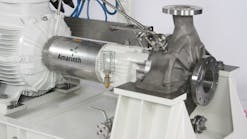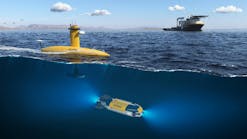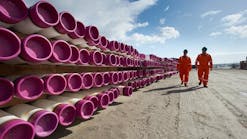William Furlow • Houston
Smaller, shallow tieback market grows
It's not just the majors and deepwater players relying on subsea tiebacks these days. What has become a cornerstone of the deepwater hub-and-spoke concept is also an attractive solution for smaller independents in conventional water depths. Bill Hakeman, with FMC Energy Systems, said his company is doing a brisk business providing mudline trees and installation services for smaller fields in water depths less than 400 ft. It turns out that the same drivers that lead majors to pursue the subsea solution are valid in conventional depths if the finds are small.
Hakeman discovered that there are a number of smaller operators in the Gulf of Mexico that are drilling wells off of jackup rigs and looking for a less expensive and faster production solution. Traditionally, such wells would be completed to a surface tree on a small, single-pile usually unmanned platform. While such a solution is nowhere near the cost of a deepwater production platform, the costs are all relative.
There are already a number of these smaller platforms in place in the shallow-water GoM. Many are producing fields that are in decline, freeing up capacity on the topsides equipment. Using established technology and a suite of tools FMC has in house, the company can turnkey the tree installation and, working with a diving contractor, can install the flowlines, risers, and control umbilical onto a host platform. Similar to the hub-and-spoke solutions in deepwater, this provides a win-win situation. The operator gets an inexpensive production solution that can be hooked up in as little as 45 days. The owner of the existing production platform can use excess processing capacity to generate additional revenue.
FMC's mudline tree is being used on a rising number of subsea tiebacks in the shallow-water Gulf of Mexico.
null
Many of the new finds on the shelf have razor-thin margins and would not be viable without this novel solution. Hakeman said his company has overcome many of the barriers that could prevent a smaller operator from participating in a subsea tieback. For example, FMC provides a full set of mudline tree tools. The company uses these tools on each job. This saves the operator the cost of purchasing and maintaining the equipment.
The tree design is basic, Hakeman said. It is typically a 10,000-psi, 3-in. stack-valve tree, though it is available in a composite block version as well. It features four downhole penetrations, and an outlet for a 4-in. flowline. It is controlled by direct hydraulics through a seven-line umbilical, giving it a tieback range of about 5 mi. FMC is looking at new designs to install in other markets as well.
Subsea power pack for up to 5,000 m
A submersible, modular power pack designed for use at 5,000-m water depth has been tested in a pressure chamber at the Center for Marine Environmental Sciences of the University of Bre-men, Germany. In the test, the power pack was exposed to a surrounding water pressure of up to 500 bar, which is equivalent to the pressure at 5,000 m water depth. The hydraulic system of the power pack, according to the switch step engaged, was operated at partial or full load up to 200 bar hydraulic pressure.
A load simulator integrated into the power pack made the assembly of an underwater work unit unnecessary for the test runs. The simulator took up the load generated by the power pack and converted it into heat. The water in the pressure chamber served for cooling purposes.
These tests were conducted on a power pack with a maximum 30 KW load capacity, but are relevant to the same type design with a higher load capacity. The 5,000-m design makes this power pack capable of serving most of the currently envisioned deepwater projects.
The power pack could be used for power cutting tools performing shearing, sawing, or milling actions, or impact tools performing pile driving operations. It also has applications in scientific exploration tools for generating shock waves below the ocean floor or collecting soil samples.
The design uses modular construction. Power packs of different sizes can be easily and quickly assembled by adding or removing modules. The most basic power pack comprises a submersible electric motor, a hydraulic pump, a pressure compensator, and a hydraulic reservoir. The parts are connected by a coupling. Since the hydraulic reservoir also serves to maintain structural integrity of the power pack, there is no need for the separate, heavy support frame commonly used in submersible power packs. The result is a lightweight, self-supporting, submersible power pack consisting of a minimum number of components tailored to meet specific job requirements.
An umbilical transmits electric power to the power pack on the sea floor. The power pack drives the underwater equipment by means of a submersible electric motor, a pump, and a short hydraulic circuit. This system provides low-loss electric energy transmission through a long electric cable to the power pack. It relies on an extremely short hydraulic circuit making it more energy efficient. Such a system is preferable, especially in deepwater. Transmitting hydraulic power from above the water surface to the underwater work location through a long, high-loss hydraulic circuit slows response time.
To maintain low flow resistance, the diameter of deepwater hydraulic hoses grows with increasing water depth. This means that even when relatively small underwater equipment is operated, a large quantity of hydraulic fluid is needed to fill the hydraulic hoses. This high volume of fluid is not needed for an underwater power pack, which is fixed directly to the underwater equipment. The extremely short hydraulic circuit contains only a few gallons of hydraulic fluid, most of which can be isolated in the case of a hose rupture.
Global to install Pemex 24-in. line
Global Industries subsidiary Global Offshore Mexico S. de R.L. de C.V. received a letter of intent from Pemex E&P to install 29 km of 24-in. pipeline from Enlace to Uech A in the Gulf of Mexico's Bay of Campeche. The project calls for the installation of the 29-km, 24-in. pipeline, three risers, three expansion loops, and the subsea tie-in. Global will also perform the trenching and five crossings related to the project. In addition, Global will conduct the hydro testing of the pipeline and topside work. The Titan 2, Cherokee, and Ingeniero II will execute the project.
Custom connection make-up
BJ Tubular Services completed a custom connection make-up operation for Applied Drilling Technology International on Tuscan Energy's Ardmore field in the North Sea. BJ carried out services from the Rowan Gorilla VII rig on ADTI's first turnkey well for Tuscan Energy located in block 30/24.
The primary objective was to make up an 11-3/4-in. thermal spray aluminum-coated produc-tion riser. The Atlas Bradford high fatigue- resistant connection had to be torqued to an optimum level of 44,200 ft/lb. To achieve this without causing excessive marking, BJ developed a 15-in. Chromemaster tong fitted with an integral back up. Using the custom Chromemaster tong, along with Chromemaster handslips, BJ completed the run of the riser well within the targeted marking criteria of 0.0l5-in.
BJ will run up to three more production risers on the Ardmore field for ADTI during the coming months.






